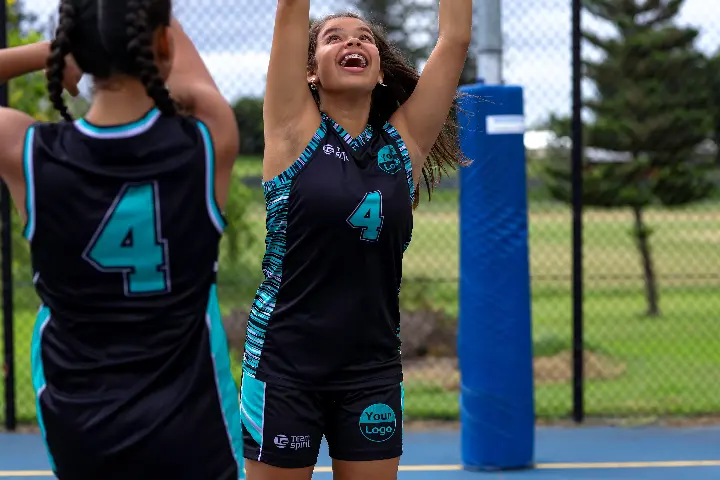Every coach, captain, and club manager knows this truth, talent wins games, but motivation wins seasons. In sport, where the difference between victory and defeat often comes down to mindset, motivation is the quiet force that keeps athletes pushing forward when things get tough.
In this article, we’ll explore what motivation in sport really means, why it matters, and how teams can use it to build stronger performance and unity both on and off the field.
Key Takeaways
- Team sports build essential life skills like communication, leadership, and resilience.
- Playing as part of a group helps children and adults develop confidence and a sense of belonging.
- Physical and mental benefits go hand in hand with teamwork and friendship.
- Coaches and parents play a vital role in nurturing positive sports experiences.
- Wearing unified team gear fosters pride, motivation, and a strong sense of identity.
What Is Motivation in Sport?

Motivation in sport is the inner drive that pushes athletes to train harder, play smarter, and never give up, even when they’re exhausted, behind on the scoreboard, or facing stronger opponents.
It’s not just about shouting encouragement during halftime or handing out pep talks. True motivation comes from within, shaped by values like teamwork, pride, and purpose.
Types and Sources of Motivation in Sport
Every athlete has a reason they show up, train hard, and give their all. Understanding what drives that effort helps coaches and leaders bring out the best in each player.
1. Intrinsic Motivation
This comes from within, the love of the game, the satisfaction of progress, and the thrill of getting better.
Intrinsically motivated athletes don’t just play to win; they play because they enjoy the challenge and growth. This kind of motivation lasts, keeping players consistent and resilient even through setbacks.
2. Extrinsic Motivation
This is driven by external rewards like trophies, praise, or scholarships. It’s not negative, when balanced well, it pushes athletes to reach higher. But if rewards become the only focus, motivation can fade once they’re gone. The best athletes blend both passion and achievement.
3. Other Forms of Motivation (Self-Determination Theory)
Motivation moves along a scale, from doing something out of obligation to doing it because it feels part of who you are.
- Introjected regulation: Training to avoid guilt or disappointing others.
- Identified regulation: Recognising the value of effort and discipline for long-term goals.
- Integrated regulation: When motivation becomes part of identity, competing and improving simply feel natural.
The closer athletes get to that integrated stage, the more self-driven and lasting their motivation becomes.
The Importance of Motivation in Sport

Motivation is at the heart of every great performance. It influences how hard athletes work, how long they persist, and how deeply they connect as a team.
1. Motivation and Performance
A motivated athlete doesn’t just push harder, they perform smarter. They train with purpose, focus on improvement, and stay composed under pressure.
When motivation is strong, athletes naturally take ownership of their development and play with confidence.
2. Motivation and Persistence
Every player faces tough moments: fatigue, setbacks, or self-doubt. What keeps them moving forward is motivation.
Athletes with a strong inner drive are more likely to stay committed, recover faster from failure, and see challenges as opportunities rather than threats.
3. Motivation and Team Culture
A motivated team is more than a group of skilled players, it’s a united force. When everyone shares the same sense of purpose, communication improves, trust deepens, and energy becomes contagious.
Motivation builds the kind of team culture where players lift each other up, fight for one another, and take pride in wearing the same jersey.
4. The Flow State, The Peak of Motivation
The ultimate expression of motivation in sport is the flow state, that moment when everything just clicks. Athletes in flow feel completely immersed in the game: movements are smooth, decisions are instinctive, and performance feels effortless.
Reaching that state isn’t luck. It’s the result of strong motivation, clear goals, and a supportive environment where players can focus on what they love most, playing their sport.
5. Motivation Builds Teams, Not Just Players
True motivation doesn’t fade at the final whistle. It shapes how players train, how they support one another, and how they represent their club.
When a team plays with shared purpose and pride, performance follows naturally. That’s why Team Spirit Sports believes motivation begins with belonging, and nothing builds belonging like a united identity, from mindset to uniform.
How to Build and Maintain Motivation in Your Team
Motivation isn’t something you can give your players once and expect to last forever, it needs to be built, reinforced, and refreshed through every season.
Here’s how coaches and team leaders can create an environment that keeps athletes inspired and focused.
1. Build Pride Through Team Identity and Unity

Pride is one of the strongest motivators in sport. When players feel connected, wearing the same colours, sharing the same goals, and playing for something bigger, they perform with heart.
That unity starts with identity. From the moment players pull on their custom jerseys or training gear, they’re reminded they belong. It’s more than a uniform, it’s a symbol of effort, trust, and pride.
Read more: Top Benefits of Custom Teamwear for Your Club or Organisation
At Team Spirit Sports, we help teams across Australia look and feel united with custom sportswear made for comfort, durability, and style. When every player wears the same colours, motivation grows naturally.
Add in small rituals, a pre-game chant, handshake, or team photo, to strengthen that bond. Because when your team looks like one, they play like one.
2. Set Clear, Realistic Goals
One of the most effective ways to sustain motivation in sport is to set clear, realistic, and measurable goals. Break them down into three levels:
- Short-term goals: daily or weekly milestones that keep players engaged, for example, improving passing accuracy or training attendance.
- Medium-term goals: achievements across a few weeks or months, like mastering a new formation or boosting fitness scores.
- Long-term goals: season-wide objectives, such as reaching finals or building stronger team chemistry.
Focus not only on outcomes (winning) but also on process goals, what athletes need to do every day to get there.
When players can see progress step by step, they stay motivated through both good days and bad.
3. Foster a Positive Team Culture and Ownership
A team culture that values respect, effort, and togetherness is the backbone of motivation. Encourage players to take ownership of their performance, involve them in setting goals, making decisions, or even leading warm-ups.
When athletes feel trusted and heard, they develop intrinsic motivation, the kind that lasts. A positive, supportive culture turns training from a duty into a shared experience.
4. Recognise Effort and Attitude
Recognition is a powerful motivator, especially when it reinforces effort, resilience, and attitude, not just results. Use small but meaningful extrinsic rewards, a team shout-out, leadership badge, or symbolic “player of the week” token, to acknowledge consistency and commitment.
These rewards work best when they highlight competence and contribution, rather than control behaviour. When players feel genuinely valued for their hard work, they naturally strive to improve.
5. Keep Training Enjoyable
Motivation thrives where fun exists. If every session feels repetitive or pressured, athletes can lose enthusiasm fast. Keep training creative, mix drills with games, challenges, or light-hearted competitions.
Add motivational music, theme days, or teamwork activities that build energy and connection. The more enjoyable the atmosphere, the more players associate effort with enjoyment, and the stronger their motivation becomes.
6. Lead by Example
Players notice everything. A motivated coach sets the tone for the entire squad.
Show up prepared, positive, and passionate. Handle losses calmly, celebrate wins humbly, and demonstrate the same discipline you expect from your team.
Leadership isn’t just about words, it’s about consistency. When athletes see your commitment, they’ll mirror it.
7. Use Self-Talk, Visualisation, and Pre-Game Routines
Mental preparation is just as important as physical training.
Encourage athletes to use positive self-talk (“I’ve got this,” “Stay calm,” “Trust your training”) to replace doubt with confidence.
Visualisation is another powerful tool, players who mentally rehearse their best moments are more likely to perform that way in real games. And consistent pre-game routines, music, breathing, or team rituals, can help players enter their optimal mental state, ready to compete.
8. Handle Motivation Over Time
Motivation in sport naturally fluctuates. There will be slumps, off-seasons, or stretches after injury when energy runs low.
To maintain long-term motivation:
- Revisit and refresh goals regularly.
- Focus on small wins and progress rather than perfection.
- Offer variety in training to avoid burnout.
- Use rest periods strategically, recovery is part of motivation too.
The most successful teams understand that motivation isn’t about constant intensity, it’s about steady, sustainable drive.
Overcoming Common Motivation Challenges

Even the most passionate teams face dips in motivation. Recognising the signs early helps coaches and players respond before it affects performance.
1. Managing Amotivation
- Amotivation happens when athletes lose their sense of purpose, they no longer see why they’re training or competing
- The best remedy is to reconnect them with their why: remind them of personal growth, friendships, and the joy of the game.
- Small confidence-building successes can reignite belief and effort.
2. Coping When Extrinsic Rewards Fade
- When external rewards (like medals or recognition) disappear, athletes might lose focus.
- Shift the emphasis back to intrinsic motivators, skill improvement, teamwork, and pride in effort.
- Reinforce how every training session contributes to long-term progress and personal achievement.
3. Dealing with Team Fatigue
- Mid-season fatigue, both physical and mental, can drain motivation fast.
- Combat it with balanced training loads, fun sessions, and clear rest plans.
- Inject fresh challenges or team goals to keep energy high and prevent burnout.
4. Navigating Personality Differences
- Not every player is motivated in the same way. Some thrive on competition; others value connection or self-improvement.
- A good coach tailors motivation to each personality, offering encouragement, responsibility, or challenge where it fits best.
- When every player feels seen and supported, the whole team performs better.
5. Turning Challenges into Growth
- Motivational dips aren’t failures, they’re opportunities for growth. They test a team’s resilience, leadership, and belief in one another.
- The best teams use these moments to strengthen trust, refine goals, and come back even stronger.
Keep the Fire Burning
Motivation is what turns effort into achievement. It’s what drives players to train harder, stay positive after setbacks, and celebrate every milestone.
Whether you’re a coach, manager, or athlete, remember, motivation isn’t about hype; it’s about heart. It grows through daily actions, shared goals, and team pride.
At Team Spirit Sports, we know motivation starts from within but shows on the outside, in how a team looks, feels, and performs together. Equip your team with confidence and pride. Explore our custom team uniforms to keep your players united, inspired, and ready to give their best.
Frequently Asked Questions
1. What are the main types of motivation in sport?
There are two main types: intrinsic (playing for love of the game) and extrinsic (playing for rewards, recognition, or results). Both can positively influence performance when balanced well.
2. How can a coach motivate their team effectively?
By setting clear goals, giving regular feedback, building trust, and fostering a positive team culture. Motivation starts from leadership.
3. How do uniforms impact team motivation?
A unified look boosts pride, belonging, and confidence. When athletes feel part of something bigger, they naturally play with more purpose.
4. Why does motivation sometimes drop mid-season?
Fatigue, pressure, or routine can lower enthusiasm. Mixing up training, recognising effort, and refocusing on team values can reignite motivation.